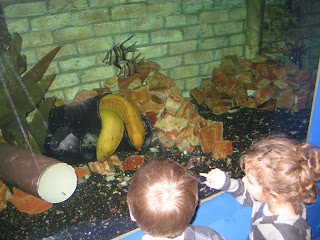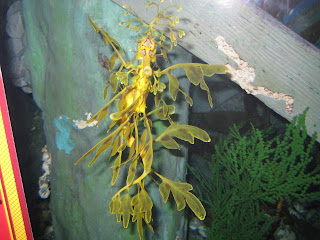On Friday we had our first excursion as a whole learning community to visit the aquarium. As you can see, our students are made of stern stuff.
Many students in our learning community have expressed an interest in creating a zoo, and have been working hard to create suitable enclosures for all the animals. To support this interest, we had some time to examine the features of various tanks after the weird and wonderful room. Our guides explained that some fish and aquatic creatures need special furniture to be happy and healthy, such as seaweed or rocks for hiding in, and baby toys to keep the octopus stimulated.
The aim of the excursion was to help spark and develop the children's interest in movement. After a quick snack on the lawn outside the aquarium, we set off to explore the "weird and wonderful room", which more than lived up to its name.
 |
| A "fish that looks like a stone" |
 |
| Eels - "it's hiding" |
 |
| Weedy Sea Dragon |
We also had a chance to feel some sea stars and sea urchins in a special feeling pool.
We discovered that we'd been getting starfish mixed up for a long time. Because have no fins, they are not actually fish at all, which is why the aquarium staff call them sea stars. We observed the movement of all the fish in each room, and discussed their anatomical features, in particular their fins and gills. The children were fascinated to discover that sea stars are unable to swim as they have no fins, and walk along the sea floor instead.
In the tropical fish room, we paused to record our observations. This proved to be quite difficult as many of the fish swam quickly in laps around the tank. We also had the chance to observe a few new types of sea creatures, such as stingrays which moved different parts of their body in different directions as they swam.
"It feels funny"
Patting the sea urchin "like a hairbrush"
We discovered that we'd been getting starfish mixed up for a long time. Because have no fins, they are not actually fish at all, which is why the aquarium staff call them sea stars. We observed the movement of all the fish in each room, and discussed their anatomical features, in particular their fins and gills. The children were fascinated to discover that sea stars are unable to swim as they have no fins, and walk along the sea floor instead.
In the tropical fish room, we paused to record our observations. This proved to be quite difficult as many of the fish swam quickly in laps around the tank. We also had the chance to observe a few new types of sea creatures, such as stingrays which moved different parts of their body in different directions as they swam.
We have had the chance since we returned to Bicicletta to finish some beautiful artwork based on the sea creatures we observed on our visit. We have also used our favourite sea creatures as inspiration for some writing and graphing work - have a look at our new maths board in our room when you have a chance.






No comments:
Post a Comment